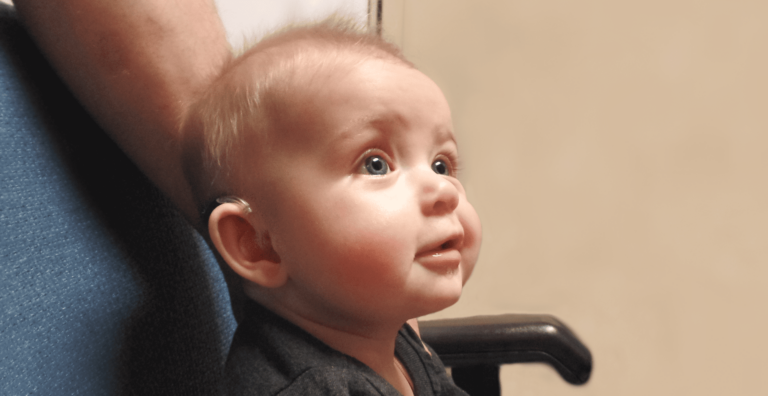
A team of researchers at Western’s National Centre for Audiology (NCA), led by director Susan Scollie, has won a Governor General’s Innovation Award (GGIA) for developing the world’s first hearing aid prescription software.
The team consists of Scollie, pioneering hearing researcher Richard Seewald, Marlene Bagatto, Steve Beaulac, Leonard Cornelisse, Shane Moodie and Sheila Moodie.
The awards celebrate excellence in innovation; inspire Canadians towards becoming entrepreneurs; and foster a culture of innovation with impact on Canadian lives.
Desired Sensation Level (DSL) software has helped clinicians worldwide provide infants and children with access to sound by helping clinicians assess, treat, and properly fit and tune hearing aids to patient’s specific needs; improving hearing outcomes, while improving long-term educational and social potential for children with permanent hearing loss.
“This is possible only because a long line of Western researchers – starting with Dr. Seewald, who was Canada Research Chair in Childhood Hearing in the 1980s, and continuing through to today’s teams of clinicians and scientists – have committed themselves to the best research, the best clinical care and the most rigorous translation of both those things to commercialization,” said Scollie

Winners of a 2022 Governor General’s Medal for Innovation for audiology technology are (front, seated) National Centre for Audiology director and Western professor Susan Scollie, Leonard Cornelisse; and (back row, left to right) Steve Beaulac, Richard Seewald, Sheila Moodie, Shane Moodie and Marlene Bagatto. (submitted photo)
Pandemic catalyst
When a rubella pandemic hit in the 1960s and 1970s, the tools and technology didn’t exist to help babies who lost their hearing. It highlighted just how essential, and how difficult, it was to develop robust hearing protocols for infants and young children with hearing loss.
But the crisis did spark Seewald and then the next generation of Western University researchers to innovate and develop accurate hearing tests and beneficial hearing aids.
Through iterations that included painstaking manual calculations, algorithms tested on an early Atari computer and programs later distributed on floppy discs, the technology evolved.
Now, 40 years later, their software and meticulous processes are embedded in hearing aids around the world and enable children and people of all ages to receive customized hearing care.
‘Down to the decibel’
Scollie said developing hearing aids for babies comes with its own set of hurdles. First is the challenge of discovering how well or poorly the young ones are processing sound. And even if they solve that, the next obstacle is understanding if a hearing aid is providing the best fit and adjustment for the infants to gain access to sound.
“If the hearing aid is too loud, the baby can’t tell them. If it is too soft, the baby can’t tell them. So, we really, really need to nail it.”
The DSL software helps solve both those issues: first, by helping discover what audio signals the baby’s brain is receiving, and then by interpreting what the hearing aids are measuring and amplifying.
And the process is precise, able to determine “down to the decibel” the safest and most effective levels for each user, Scollie said.
DSL-version 5.0 (the latest iteration of the line) measures more than 250 parameters per hearing aid – a giant leap from the early days when researchers created and verified the processes by pencil and paper, and then by calculator.
Today, their hearing aid prescription software and clinical procedures are used worldwide. They are the primary strategy in 80 to 95 per cent of pediatric clinics across North America, and recommended best practices in Canada, the United Kingdom, Germany, and many other countries worldwide.
Virtually every major hearing-aid company in the word has this software embedded into their products.
- National Centre for Audiology director Susan Scollie
- Richard Seewald and Frances Richert with child in 2006. (Submitted photo)
A Western ‘success story’
DSL and its iterations are trademarked. Commercialization is managed through WORLDiscoveries, the technology transfer partnership among Western, Robarts Research Institute, and Lawson Health Research Institute.
Licensing agreements ensure manufacturers maintain quality control standards as outlined by the team and by research-backed studies. Manufacturers, in turn, send their hearing aids and software back to NCA for testing to check for accuracy.
“When they know what it’s for and why, for the babies and children, it’s heartwarming for them to make sure they get it right, too,” Scollie said.
The success of this technology can be traced to a large and collaborative team that had its genesis with Seewald and his original team, and evolved through the formation of the NCA in 2001.
Scollie noted the GGIA recognition is a Western success story as much as it is an NCA and DSL success story. She was part of the first year of the PhD audiology program at Western, and all the principal researchers are also Western-trained.
The NCA contributions to this specialty include more than 100 publications in leading and high-impact scientific journals.
“We’re one of the largest research centres in the world.”
The team is one of just six GGIA recipients across the country this year. The innovation award will be presented during a virtual ceremony by Governor General Mary Simon on May 19.
“The awards are not intended for lifetime achievement or innovations that have not yet demonstrated impact,” the award page reads. “Rather, by recognizing active, current innovators across the breadth of our economy and society, the awards help foster an active culture that celebrates innovation that is having a meaningful impact on our lives.”

